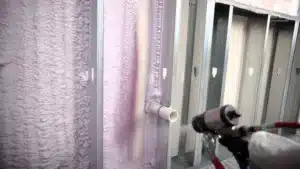Wall Insulation Garner | Installation Tips
In Garner’s mixed-humidity climate, proper wall insulation is pivotal for year-round comfort, energy savings, and indoor air quality. From crawlspaces to exterior walls, understanding insulation materials, R-values, installation methods, and local best practices can transform your home’s performance. This comprehensive 4,000-word guide covers everything: core principles from our Cornerstone Insulation Guide, detailed breakdowns of insulation types, step-by-step installation tips, Garner-specific code requirements, LSI keywords like “exterior wall R-value Garner,” and more. You’ll also find homogenous internal links to related articles and authoritative external resources, plus illustrative images with alt text to enrich your understanding.
1. Why Wall Insulation Matters in Garner
Garner’s humid summers and cool winters mean poorly insulated walls can lead to significant temperature swings and high utility bills. According to the Insulation Institute, up to 35% of a home’s heating and cooling energy can be lost through uninsulated walls. Benefits of upgrading include:
- Lower energy bills by up to 20%–30% (HomeAdvisor).
- Enhanced comfort with stable indoor temperatures and reduced drafts.
- Improved indoor air quality by controlling moisture and mold growth.
- Noise reduction from external sources.
- Higher home resale value thanks to energy-efficient credentials.

2. Cornerstone Principles: Insulation Basics
Begin with our Cornerstone Insulation Guide to master:
- R-Value Fundamentals: The measure of thermal resistance.
- Air Sealing: Preventing convective heat losses.
- Moisture Control: Vapor barriers and drainage planes.
- Thermal Bridging: Minimizing conductive paths through framing.
3. Recommended Wall R-Values for Climate Zone 3
According to the 2018 IECC (Climate Zone 3):
- Wood-framed walls: R-13 to R-21 (2×4 to 2×6 framing).
- Masonry walls: R-5 to R-13 continuous exterior insulation.
- Historic retrofits: Use dense-pack cellulose or spray foam for cavity fill.
4. Types of Wall Insulation
4.1 Fiberglass Batts & Rolls
Cost-effective, pre-cut batts fit between studs. Typical R-13 to R-21 for 2×4 and 2×6 walls.
4.2 Blown-In Loose-Fill
Cellulose (R-3.5/in) and fiberglass (R-2.7/in) blown into existing walls via holes, ideal for retrofits. Learn more: Blow-In Insulation.
4.3 Spray Foam (Open & Closed Cell)
Open-cell (R-3.6/in) and closed-cell (R-6.5/in) spray foam offer air sealing and cavity fill. Details: Spray Foam.
4.4 Rigid Foam Board & Continuous Insulation
Polyiso, XPS, and EPS boards add continuous exterior insulation, reducing thermal bridging.

4.5 Mineral Wool (Rockwool)
R-15 to R-23, water-resistant, fireproof, excellent sound control. Specs: Rockwool.
5. Installation Methods
5.1 New Construction
- Frame Inspection: Check studs for straightness and spacing.
- Air Sealing: Seal rim joists and top plates.
- Insulation Placement: Install batts or panels snugly without compression.
- Air & Vapor Barriers: Apply house wraps and interior vapor retarders as needed.
5.2 Retrofit & Existing Walls
- Drill Access Holes: Between studs on interior or exterior face.
- Blow or Spray: Inject insulation material uniformly.
- Seal & Patch: Fill holes, repair surfaces, and finish.
6. Air Sealing & Moisture Management
Before insulation, seal gaps around windows, doors, plumbing, and wiring. Use low-expanding foam for penetrations. Ensure proper drainage with flashing and house wrap per This Old House recommendations.
7. Local Code & Incentives in Garner
- Wake County IECC 2018 requirements.
- Federal Tax Credit: 10% of insulation costs, up to $500.
- NC Clean Energy rebates and Duke Energy programs.
8. Related Internal Links
9. Maintenance & Upgrades
Inspect walls during renovations for settling or moisture. Add blown-in insulation or replace batts during siding or drywall projects.
10. Case Study: Garner Home Improvement
A 3,200 sq ft Garner home upgraded exterior walls with R-10 continuous foam and cavity-packed cellulose, reducing energy costs by 25% and improving year-round comfort.
11. External Resources for Further Reading
Conclusion
Investing in wall insulation in Garner is a high-impact home improvement that delivers energy savings, enhanced comfort, and improved indoor air quality. By selecting appropriate materials, following best installation practices, and leveraging local incentives, homeowners can achieve lasting benefits and boost property value.
FAQ
1. What R-value should I use for walls in Garner?
For 2×4 wood-frame walls, R-13 to R-15; for 2×6 framing, R-19 to R-21. Consider continuous exterior insulation for masonry walls.
2. Can I retrofit insulation without removing drywall?
Yes—blown-in cellulose or foam injection methods allow retrofit through small drilled holes.
3. How do I control moisture in wall cavities?
Use vapor barriers on the warm side, proper flashing, and house wraps to manage water intrusion.
4. Are spray foam and blown-in cellulose both suitable?
Yes—spray foam adds air sealing, cellulose is cost-effective and eco-friendly. Choose based on budget and performance needs.
5. What incentives are available?
Federal tax credits, state clean energy rebates, and utility weatherization programs often apply. Check current offerings before starting.
For expert wall insulation services in Garner, contact Home Tech Insulation: info@hometechinsulation.com | (919) 555-1234

